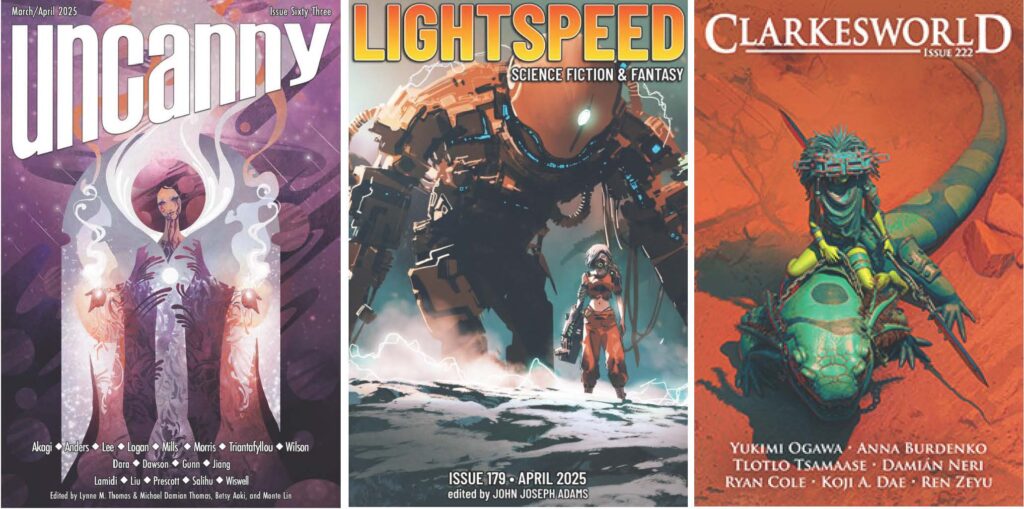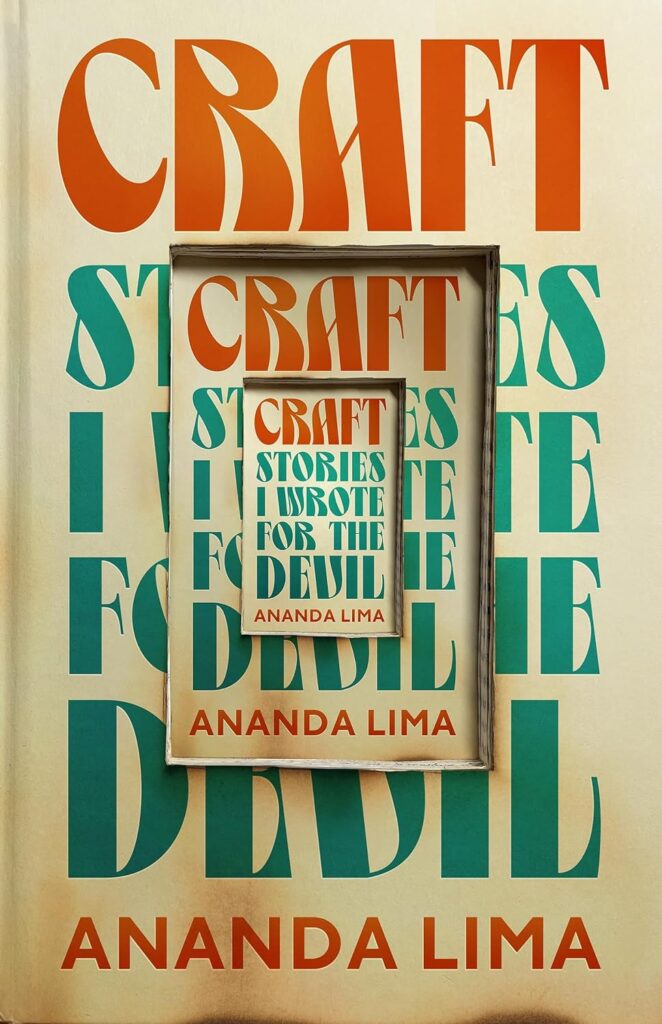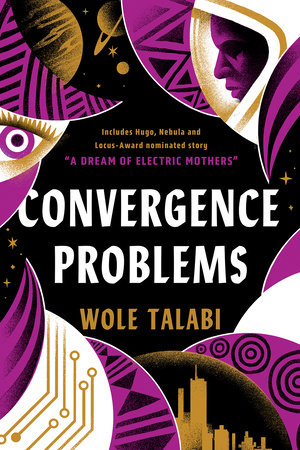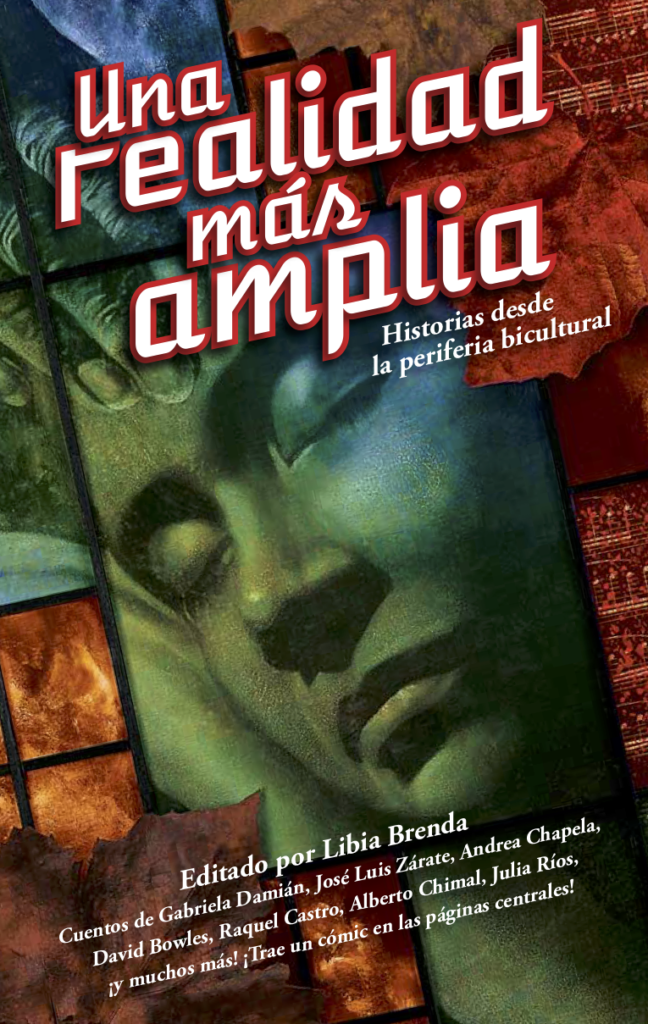Short Fiction Review: March–April 2025

My favorite stories from March and April all lift up the importance of human connection in one way or another.
Book Review: CRAFT: STORIES I WROTE FOR THE DEVIL by Ananda Lima

At the dawn of the Millennium, a writer attends a Halloween party and meets the Devil. She’s come dressed as a distinct reference to the past: Inauguration Nancy Reagan. He’s dressed in a baggy suit with a rumpled orange wig. When she asks the Devil what he’s supposed to be, he simply answers: The future. Cue terrifying shiver in readers. So begins Craft, and so starts a series of encounters between the writer and the Devil. While those future meetings will be neither as prolonged nor as intimate as this first, the effects of each experience will profoundly influence the progression of the writer’s art: her craft. The magic of Lima’s debut work is its effective amalgamation of form, genre, and theme. Craft is most recognizable as a collection of short stories with interludes of the meetings between the writer and the Devil through time. But readers will quickly find the numbered stories blending into one another, and the unnumbered interludes blending into the stories, to the point where Craft manifests characteristics more particular to a novel, united with a third-person omniscient perspective that may not be as fragmented as a collection would normally have. Craft is also most recognizable as literary fiction, with an emphasis on words, writing, and ideas that dominate plot or character. Yet it also conjures the realms of genre, and is published by Tor Nightfire, a horror imprint. The stories, or episodes, of Lima’s debut are reminiscent of the surreal fiction and magical realism that previous generations of Central and South American authors have pioneered. A Brazilian expat settled in the United States, Lima offers a unique and personalized perspective in Craft that addresses the immigrant experience, with inspiration from the difficult years since the US election of 2016, through the SARS-CoV-2 pandemic, up to the present. At points, Lima compares and contrasts elements of the political administration of her current home, to the that of her homeland where family still lives. I describe this as if the writer who appears in Craft is an autofiction stand-in for Lima herself. Possibly. Possibly not. Here again, Lima’s work exists as a blending with uncertain definition between fiction and memoir. Are these biographical details of truth that Lima has put into Craft from her experiences? Are they a broader truth, related with completely fabricated details? Lima writing a writer character who writes stories inspired by events and encounters with the charismatic enigma of the Devil makes a large portion of Craft meta, with frequently amusing commentary on the process of writing – particularly the vagaries of peer review. “Idle Hands”, one of the ‘stories’ in Craft, consists entirely of notes, or reports, written by members of a writer’s group as critique of a short story the writer has produced in the workshop. All the perspectives combine into a contradictory and impossible-to-address mess of opinions and points of view, creating an ambiguous idea of what the actual story may have been and the realm of possibilities for its strengths or weaknesses. The most surreal entry of Craft (and a brilliant one), “Antropófaga”, features a wearied woman who discovers a vending machine at work that dispenses miniature little American people of various types, in crisp plastic packaging for consumption like candy. Equally brilliant on the other end of the spectrum of realism would be an entry like “Ghost Story”, using magical realism to explore separation of people in ordinary situations. Returning to the topic of Craft‘s publisher, one might wonder how horror enters into the picture here. Indeed, from what I can gather through brief research, Lima herself was surprised that her work could be characterized or marketed as such. Horror fans who are familiar with the very broad spectrum of the genre won’t be surprised here, but casual horror fans or those who normally avoid horror might be more confused through preconceptions or expectations. Craft is not about eliciting constant terror or fright – or about pulling jump scares. It’s not filled with gore or overt violence. It’s a vibe. A disquieting soul that draws from our own collective experiences over the past decade (or even beyond) and the nightmare that may exist in our realities. And it’s about living through them and finding oneself even through the uncertainties and unfairness of it all. Craft also evoked the horror genre for me a bit through its structure, particularly compared to the common format for horror anthology movies. These usually consist of multiple independent stories, with a bridging narrative between each to hold them all together. At times, the worlds of each episode and the interludes meet one another in meta fashion. Craft contains this same effect, with the unnumbered (and untitled) interludes serving as this type of cinematic bridge narrative. Similar to this form in movies, the bridging narrative never quite gels in strength compared to many of the distinct episodes, yet contains fragments of brilliance and serves as that essential glue for the whole. Lima’s Craft is well worth checking out for genre fans that like the literary fiction side of the spectrum (or the reverse.) I’d also recommend looking into other reviews if interested (or still undecided) that go more into specific stories. I often find myself writing reviews that disagree with a lot of other opinions out there, or see different things, but in the case of Craft, most of the coverage seems fair and on-point.
Short Fiction Review: February 2024

My favorite story from February was “Why Don’t We Just Kill the Kid In the Omelas Hole” by Isabel J. Kim … My other favorite stories from February all took the form of in-world artifacts of some sort.
Book Review: CONVERGENCE PROBLEMS by Wole Talabi

“… (E)ven the most widely read out there will find something new here, and something of significance.”
384. The 2020 Nommo Awards Short Story Short List! (Reading Rangers)

https://media.blubrry.com/skiffyandfanty/dts.podtrac.com/redirect.mp3/archive.org/download/sand-f-384-2020-nommo-awards/SandF_384_2020NommoAwards.mp3Podcast: Play in new window | DownloadSubscribe: Apple Podcasts | Spotify | Android | Email | TuneIn | Deezer | RSS Concentrated sin, collective intelligences, and space cannibalism, oh my! Jen and Shaun are at it again (again) with another Reading Rangers format. This time, they explore the short story short list for the 2020 Nommo Awards! This one is a meaty podcast, folks. We’ve got a lot of stories to discuss, from tales of artificial intelligence to generation ship cannibalism, beings who consume the evil among us to haunted houses and their haunted tenants, and spiritual messengers and balancing acts to unusual powers and the trauma we hide. Thanks for listening. We hope you enjoy the episode!
Reading Rangers: Shorts #4 – A Larger Reality: Speculative Fiction from the Bicultural Margins / Una realidad más amplia: Historias desde la periferia bicultural

https://media.blubrry.com/skiffyandfanty/dts.podtrac.com/redirect.mp3/archive.org/download/SandFReadingRangersShorts4MexicanxInitiativeALargerReality/SandF–ReadingRangersShorts4–MexicanxInitiative_ALargerReality.mp3Podcast: Play in new window | DownloadSubscribe: Apple Podcasts | Spotify | Android | iHeartRadio | Podchaser | Podcast Index | Email | TuneIn | Deezer | RSSRangers Trish, Brandon, and Daniel are back after their long break to tackle an anthology that is near and dear to our hearts. To be fair, our very own Julia Rios is part of it. Plus, we’re big fans of John Picacio and his MexicanX Initiative, and some of the initiative’s participants contributed stories to said anthology. That’s right! We’re talking about A Larger Reality: Speculative Fiction from the Bicultural Margins / Una realidad más amplia: Historias desde la periferia bicultural edited by Libia Brenda! The Rangers dig their heels into the stories to examine their styles and themes. They also discuss the thematic and tonal pairing of the stories and how they worked together to create the wonderful, FREE anthology from the MexicanX Initiative! We hope you enjoy the episode!

